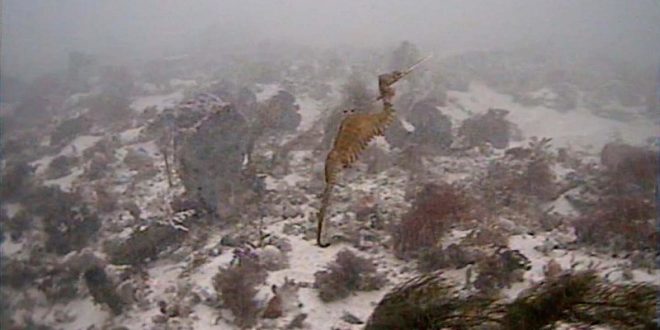Ruby seadragon, scientific name Phyllopteryx dewysea, has been captured in video off the coast of Australia. This elusive creature is the cousin of the common seadragon and the leafy seadragon but has no extravagant appendages.
Video footage of the ruby seadragon, captured using a remotely operated vehicle with a low-light video camera, shows off its intense red colour and reveals that its habitat is very different from the algal reefs occupied by its relatives. The footage also reveals some striking differences between the three species.
Professor Greg Rouse, Scripps Oceanography, lead author of the study said: “Until recently, no one had ever suspected a third species of seadragon existed. This discovery was made thanks to the great benefit of museum collections.”
The first documentation of living ruby seadragons presented in this study shows that the fish live at a depth of more than 50 meters – beyond recreational SCUBA diving limits. The researchers suggest that this may be why the species went undiscovered for so long. Its closest relatives, the leafy and common seadragon, inhabit much shallower depths of 3-25 meters.
One unique characteristic of the ruby seadragon is that it lacks leaf-like appendages – a distinctive feature of the bodies of common and leafy seadragons, which camouflages the fish among the sea grass and kelp meadows in which they live. The researchers suggest that because ruby seadragons occupy a much sparser and less brightly lit habitat than their relatives, they rely on their red colour for effective camouflage.
Josefin Stiller, Scripps graduate student and coauthor of the paper said: “It was really quite an amazing moment when we discovered that the ruby seadragon lacks appendages. It never occurred to me that a seadragon could lack appendages because they are characterized by their beautiful camouflage leaves.”
The researchers were also surprised to find that the ruby seadragon has a prehensile tail which it may use to hold on to objects to avoid being swept away by strong sea surge. Common and leafy seadragons cannot bend their tails, which raises questions about the evolution of tails in this group of organisms, according to the researchers. Further study is needed to clarify whether the ruby seadragon has re-acquired a prehensile tail that was lost in a common ancestor, or if the absence of a prehensile tail in the common and leafy seadragons has independently evolved in each of the species.
Nerida Wilson, Western Australian Museum, a coauthor of the study said: “There are so many discoveries still awaiting us. Western Australia has such a diverse range of habitats, and each one is deserving of attention.”
To obtain their first live observations of the ruby seadragon, the researchers explored the Recherche Archipelago in Western Australia in April 2016. They were able to observe two ruby seadragons for nearly thirty minutes which yielded insights into the morphology, habitat, and behavior of the fish.
There remains a lot to understand about the ruby seadragon, such as whether it is facing any threats, or how widespread its distribution is. Researchers are only just beginning to understand how leafy and common seadragon populations are connected, and have much to understand about the newest member of the group.
Agencies/Canadajournal
 Canada Journal – News of the World Articles and videos to bring you the biggest Canadian news stories from across the country every day
Canada Journal – News of the World Articles and videos to bring you the biggest Canadian news stories from across the country every day



